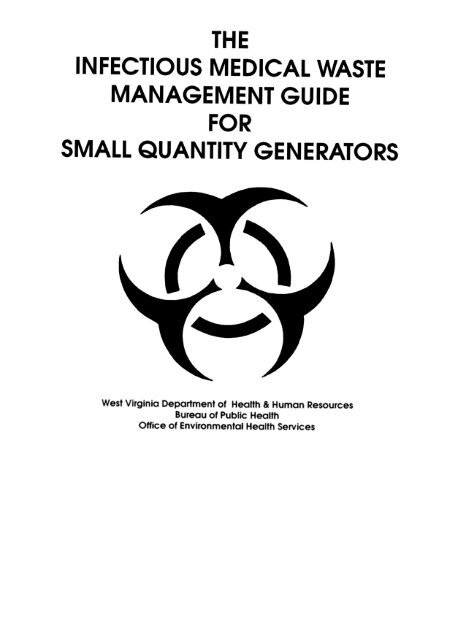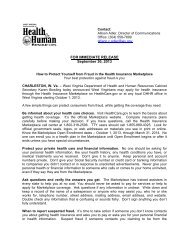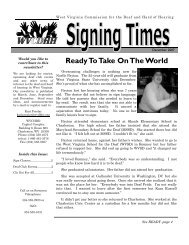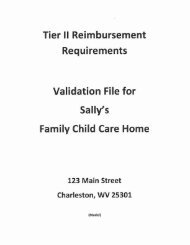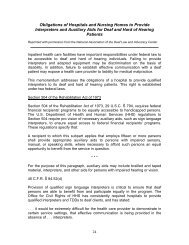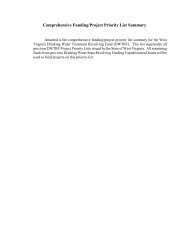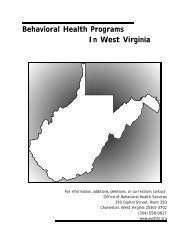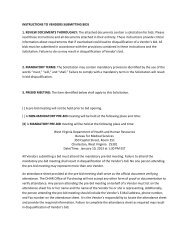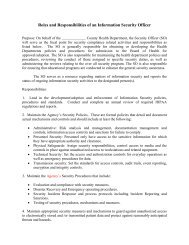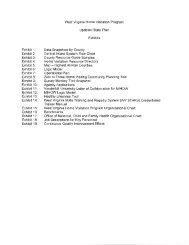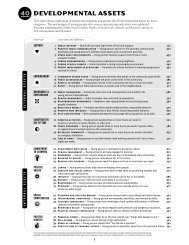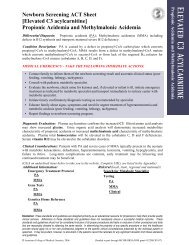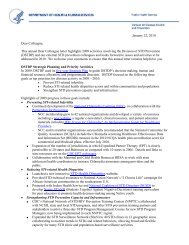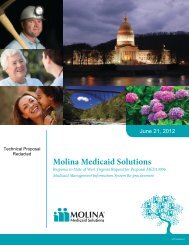Small Quantity Generators Infectious Medical Waste Guide - DHHR
Small Quantity Generators Infectious Medical Waste Guide - DHHR
Small Quantity Generators Infectious Medical Waste Guide - DHHR
You also want an ePaper? Increase the reach of your titles
YUMPU automatically turns print PDFs into web optimized ePapers that Google loves.
West Virginia Department of Health & Human ResourcesBureau of Public HealthOffice of Environmental Health Services
West Virginia Department of Health & Human ResourcesBureau of Public HealthOffice of Environmental Health Services<strong>Infectious</strong> <strong>Medical</strong> <strong>Waste</strong> ProgramMorrison Building, 815 Quarrier Street, Suite 418Charleston, WV 25301-2616(304) 558-2981
<strong>Small</strong> quantity generators generate less than 50 pounds of medical waste In a one month period.<strong>Infectious</strong> medical waste Is defined as medical waste capable of producing a disease In man.Excludedor ExemQted:.Human remains under control of a physician. mortician or dentist.Garbage or trash.Household medical waste Cexcept sharps).Treated and destroyed medical wastes.Ash from medical waste incinerators.Hair. nails and extracted teeth.<strong>Medical</strong> tubing and devices certified as non-infectious by the generatorThe mixture of infectious medical waste and non-hazardous solid waste is considered aninfectious medical waste.The mixture of infectious medical waste and hazardous waste is regulated as a hazardoussubstance and different rules apply.Non-infectious medical waste is solid waste.
~INFECTIOUS MEDICAL WASTE MANAGEMENT PLANAll small quantity generators are required to develop and follow a waste management PLAN .The PLAN must be on file on the premises and be made available for Inspection. It shall besubmitted to the Secretary of the Department upon request .
Sharps: Segregate sharps from other regulated infectious medical waste. All discardedsharps must be placed in rigid. leak- and puncture-resistant containers. clearlymarked "infectious medical waste."When stored or to be treated off-site. place container in a red plastic bag.Sharps rendered non-infectious and encapsulated in a solid state on-site, may bedisposed of as solid waste.Fluids:May be discharged to an approved sanitary sewer or contained in break-resistant, tightlystoppered containers.Other: Place in red-colored. disposable, leakproof, rip-resistant bags. passingASTM D-959-80 using 125 pounds or be 3 mils thick, or containers with equivalantcontainment properties.Storage<strong>Waste</strong> other than sharps may not be stored more than 30 days. even if refrigerated.Maintain Integrity of container -and in a non-putrescentstate.Storage area shall be durable, easily cleanable, impermeable to liquids and vermin-proof.Protect containers from adverse weather, in a locationwhich limits public access.Reusable containers must be decontaminated each time there are visible signs of contamination.
~Steg 2.SECONDARYCONTAINER,Place red bags in leakproof, disposable or reusable, double-wall corrugated fiberboard boxes orequivalantrigid containers.Secondary containers do not have to be red, but they must be clearly labeled as infectiousmedical waste.The label must also carry your name, address, date of packaging, plus the transporter's name.address and his permit and telephone numbers..
~SteQ 3.TRANSPORTINGYou, or a trained employee, may transport your medical wastes to a permitted infectious medicalwaste treatment facility (e.g., a hospital).You may choose to use a permitted hauler.IBefore you hire a transporter. you must verify that he has a valid permit. issued by the Secretary ofthe Department .Sharps may be shipped as registered mall through the U .5. Postal Service if you comply with allpostal regulations.
All infectious medical waste must be rendered non-infectious by incineration.steam treatment, discharge to an approved sanitary sewer or alternative methodsapproved before disposal by the Secretary of the Department .Unrecognizable treated infectious medical waste may be disposed of as solid waste. Treatedmedical waste that will pass through a screen with a 1/2 inch grid will be considered notrecognizable.Recognizable treated infectious medical waste must be labeled before disposal. The labelmust contain the statement: .1 hereby certify , under penalty of law, that this waste has beenrendered non-infectious in accordance with the procedures required by <strong>Infectious</strong> <strong>Medical</strong><strong>Waste</strong> Rule. 64 CSR 56."Persons handling infectious medical waste shall have a working knowledge of pathogensand how diseases are transmitted.Personnel shall be familiar with the facility's infectious medical waste management plan.Personnel shall have working knowledge of minimum requirements for handling and storinginfectious medical wastes.Personnel shall be familiar with the procedures, materials and equipment to be used in spillcleanup.For more details, please refer to the <strong>Infectious</strong> <strong>Medical</strong> <strong>Waste</strong> Rule ( 64 CSR 56 ), or addresscomments or questions to:<strong>Infectious</strong> <strong>Medical</strong> <strong>Waste</strong> ProgramOffice of Environmental Health Services(304) 558-2981
~<strong>Infectious</strong> <strong>Medical</strong> <strong>Waste</strong> Management PlanFor
A. TYPE OF MANAGEMENT FACILITYBusiness T elephoneEmergency Telephone~Contact PersonB. INFECTIOUS MEDICAL WASTE GENERATED (See Appendix A)It is estimated that this practice will generate the following quantities of infectious medical wasteduring a one-monthperiod:IYf£#/month1. Culture & stock of microorganisms and biologicals2. Blood and blood products3. Pathological wastes4. Sharps5. Contaminated animal carcasses, bedding, etc.6. Contaminated isolation wastes7. OthersTotalIf you generate 50 pounds or more during a one-month period you become a large quantitygenerator and additional regulations apply.
c. STORAGE.General:.Yes .No Are infectious medical wastes (IMW) separated from other medical wastes?.Yes No Other than sharps, are IMW stored for 30 days or less?-YesNoAre IMW maintained in a non-putrescent state?.Yes ,No Is the storage area for IMW durable. easily cleanable. impermeable to liquidsand vermin-proof?.Yes No Are IMW containers stored in a manner and location which afford protectionfrom the weather and limit public access?-Yes .No Are reusable IMW containers decontaminated if there are visable signs ofcontamination?If so, what sanitizer is used?.Yes No Is IMW, other than sharps, delivered within 45 days to a permitted storage ortreatment facility?2. SharRs:.Yes No Are sharps segregated from other IMW, and placed in rigid, leakproof, andpuncture resistant containers clearly marked "<strong>Infectious</strong> <strong>Medical</strong> <strong>Waste</strong>"?Name of product container.Yes No Are sharps treated on-site?If yes. what method is being used?Steam treatmentRendered non-infectious -Encapsulated in a solid state -Others -
3. Fluids:.Yes .No Is the liquid IMW being dicharged to an approved sanitary sewer? Or..-Yes No Is the liquid IMW contained in a break-resistant, tightly stoppered container?--Yes .No Are containers of sharps and other IMW to be treated off-slte being placed ina red-colored. disposable, leakproof, rip-resistant bag?Yes .No Does your name, address and the date of packaging appear on eachprimary container?-Yes .No Are the red bags placed in leakproof, disposable or reusable, double-wallcorrugated fiberboard boxes or equivalent rigid containers?Yes .No Are the red bags clearly marked "<strong>Infectious</strong> <strong>Medical</strong> <strong>Waste</strong>"?-Yes No Do secondary containers have your name, address, the date of packaging,the transporter's name, address, permit and telephone numbers?.Yes No Will a permitted hauler be employed? Who?NameAddressPhone NumberPSC Permit Number (if applicable)<strong>DHHR</strong> Permit Number---
~-Yes No Is all hauler-transported IMW properly manifested?YesNo-YesYes No Do you have a contingency plan that wIll provide contacts to mitigate anyInterruptions In transportation ?NoAre sharps being shipped to a treatmen~taclllty?IF. TREATMENTName and location of Treatment FacIlity being used:Type of treatment:G. DISPOSALName and locationof Disposal Site being used:-YesNoAre alllMW records maintained for three (3) years?
~Attach any policies and procedures which you have developedrelated to <strong>Infectious</strong> <strong>Medical</strong> <strong>Waste</strong>.Any "no" answer. except In Section C-3, may require modification of your plan.If several health care professslonals operate one facIlity ,where they share clerical and nursing staff and In other ways act as one unit ,the total amount of <strong>Infectious</strong> medical waste generated In a one-month periodshall be the total generated by gU health care professionals Involved in the operation.DATE ADOPTED
Definitions<strong>Infectious</strong> <strong>Medical</strong> Wast§; -<strong>Medical</strong> waste which is capable of producing an infectious disease.<strong>Infectious</strong> medical waste shall be considered capable of producing an infectious disease if it hasbeen, or is likely to have been, contaminated by an organism likely to be pathogenic to healthyhumans, if such organism is not routinely and freely available in the community, and such organismhas a significant probability of being present in sufficient quantities and with sufficient virulence totransmitdisease.Animal carcasses. body carts. beddina and relat -Contaminated animal carcasses,body parts and bedding of animals that are known to have been exposed to infectious agentsduring research, production of biologicals, testing of pharmaceuticals or any other reason.Blood and blood Droducts -Liquid waste human blood and blood products in a free-flowing orunabsorbedstate.Cultures and stocks of microoraanisms and biolQgil -Discarded cultures. stocks. specimans.vaccines and associated items likely to have been contaminated by an infectious agent. Discardedetiologic agents are infectious medical waste. <strong>Waste</strong>s from the production of biologicals and antibioticslikely to have been contaminated by an infectious agent are infectious medical waste.Isolation wastes -<strong>Waste</strong>s generated from the care of a patient who has, or is suspected of having,any disease listed as Class IV in "Classification of Etiologic Agents on the Basis of Hazard," publishedby the United States Centers for Disease Control.Patholoaical waste -Human pathological wastes, including tissues, organs, body parts andcontainers of body fluids, exclusive of those fixed in formaldehyde or another fixative.SharDs -Discarded articles that may cause punctures or cuts and that have been used in animal orhuman patient care or treatment, or in pharmacies or medical, research or industrial laboratories,including, but not limited to, hypodermic needles, syringes with attached needles. scalpel blades,lancets and broken glassware.


